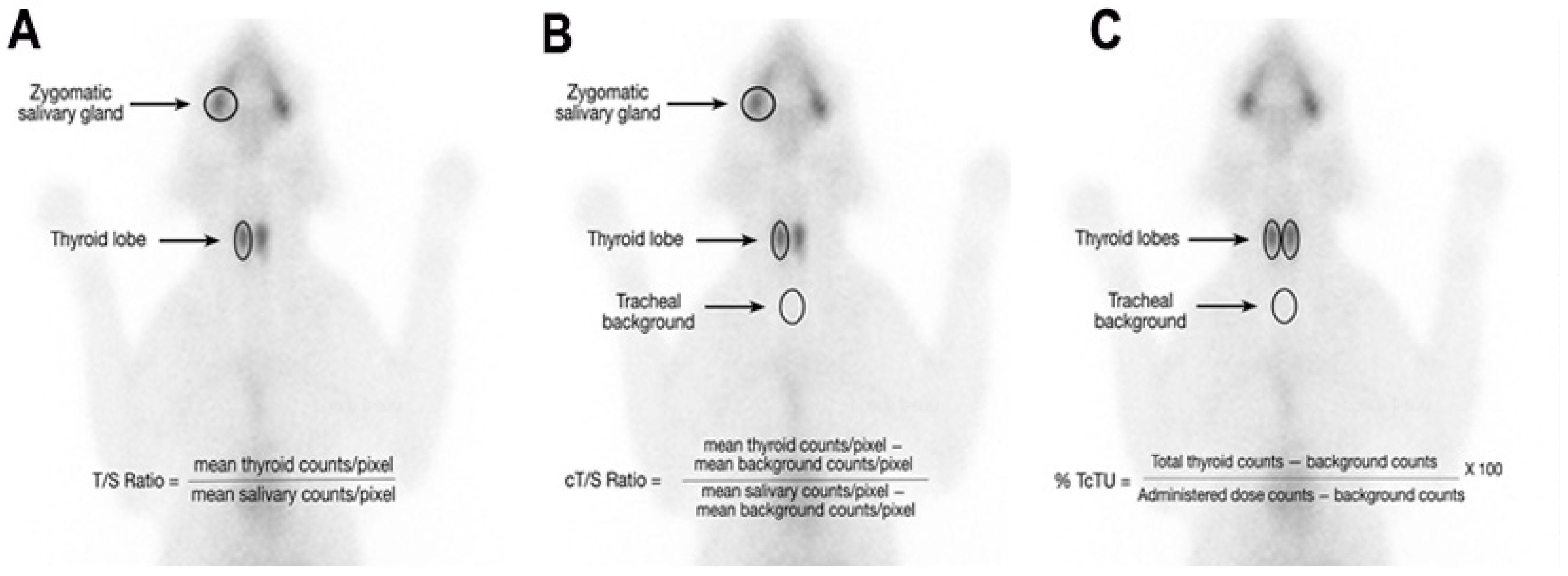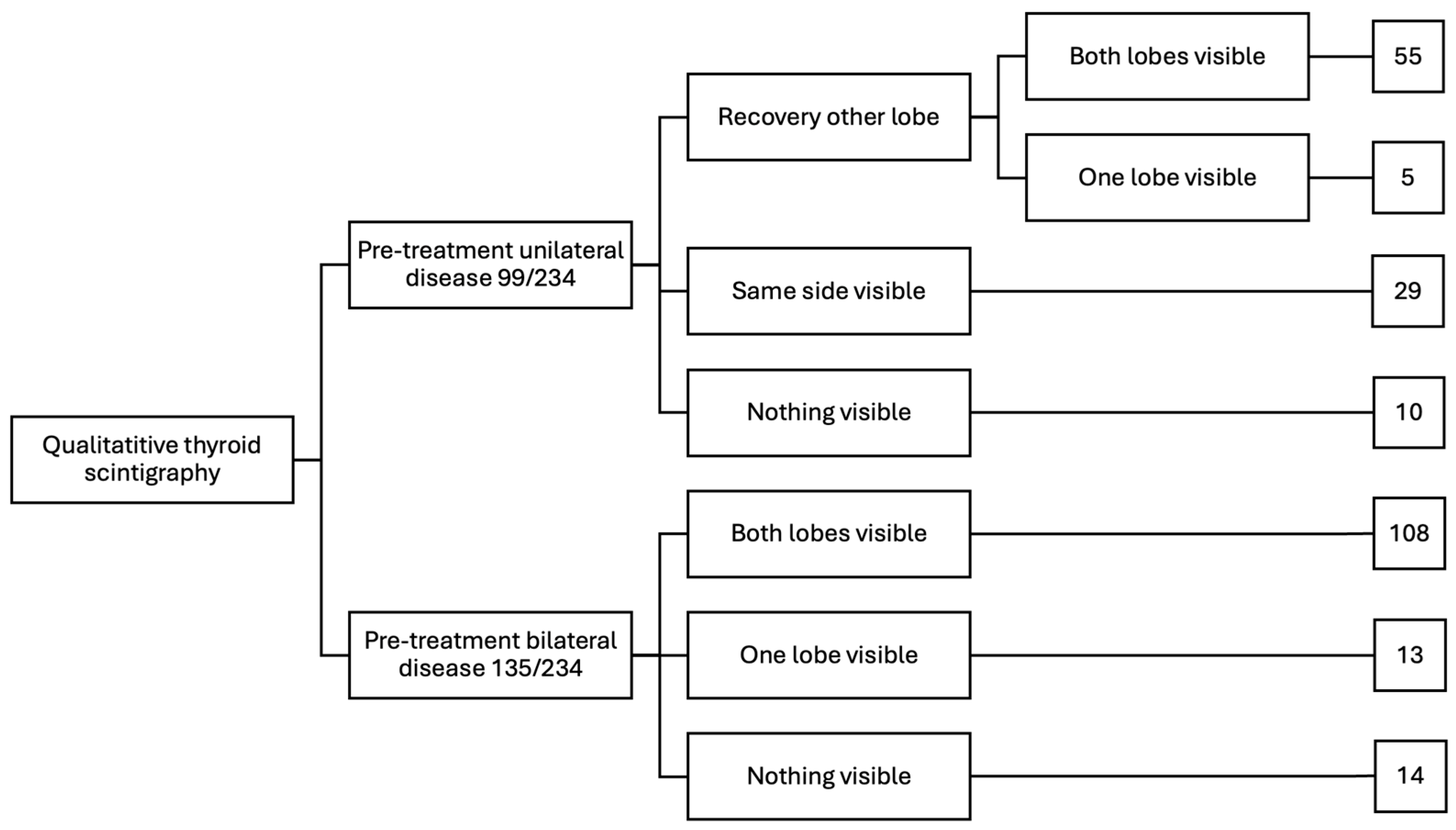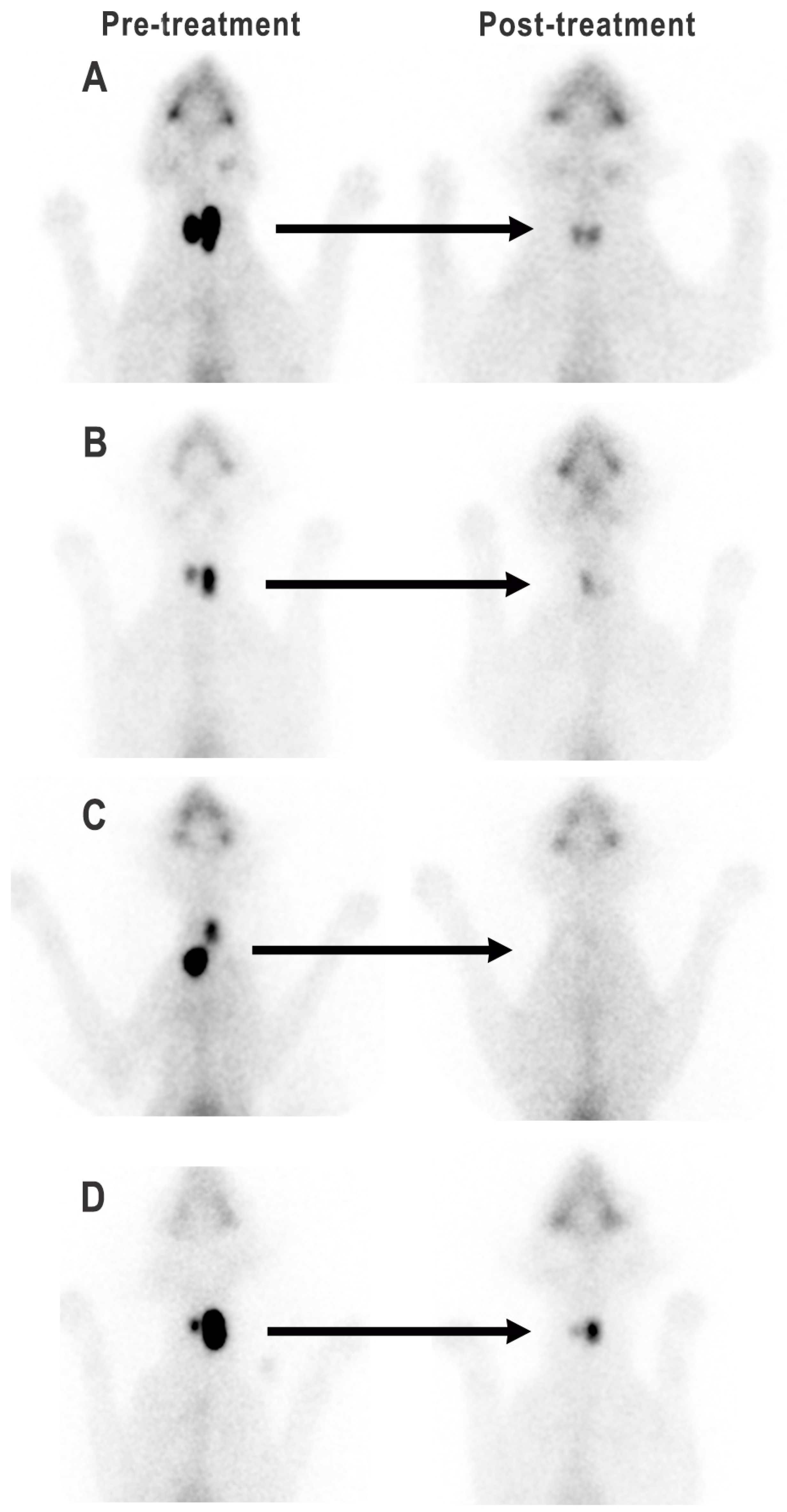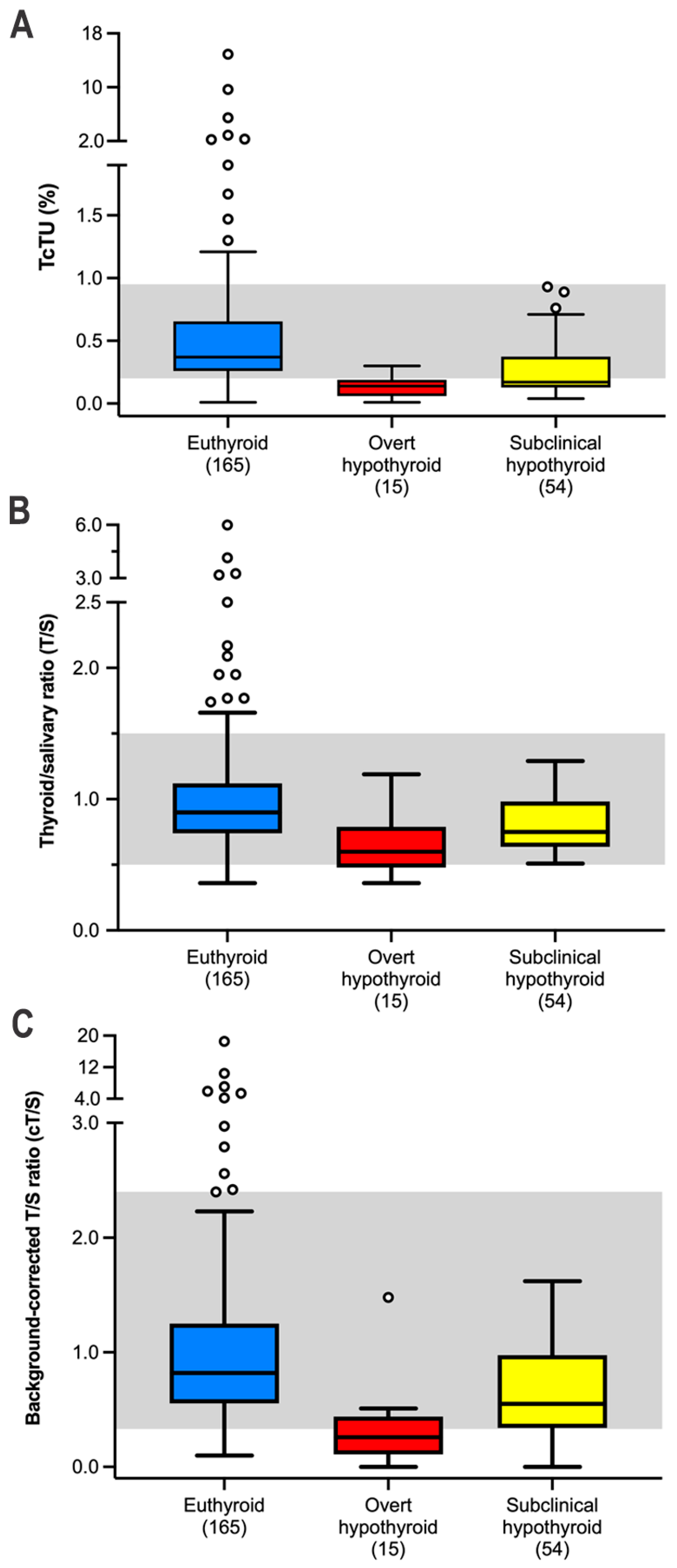Thyroid Scintigraphy Findings in 234 Hyperthyroid Cats Before and After Radioiodine Treatment
Simple Summary
Abstract
1. Introduction
2. Materials and Methods
2.1. Study Population and Design
2.2. Thyroid Scintigraphy
2.2.1. Pre-Treatment Scintigraphy
2.2.2. Post-Treatment Scintigraphy
2.3. Data and Statistical Analysis
3. Results
3.1. Pre-Treatment Characteristics of Hyperthyroid Cats
3.2. Pre-Treatment Thyroid Scintigraphy in Hyperthyroid Cats
3.3. Dose of Radioiodine Administered to Treat Hyperthyroid Cats
3.4. Post-Treatment Serum Concentrations of T4, TSH and Creatinine
| Variable | All Cats (234) | Euthyroid (165) | Overt Hypothyroid (15) | Subclinical Hypothyroid (54) | p Value |
|---|---|---|---|---|---|
| Serum creatinine (mg/dL) | 1.6 (1.3–1.9) | 1.5 a,b (1.3–1.8) | 2.1 a,c (1.7–2.6) | 1.7 b,c (1.4–2.1) | <0.0001 |
| Serum T4 (µg/dL) | 1.7 (1.3–2.1) | 1.9 a,b (1.6–2.3) | 0.8 a,c (0.6–0.9) | 1.4 b,c (1.1–1.7) | <0.0001 |
| Serum TSH (ng/mL) | 0.11 (0.04–0.48) | 0.07 a,b (0.03–0.13) | 6.2 a,c (3.6–12.0) | 0.88 b,c (0.52–2.45) | <0.0001 |
| TcTU (%) | 0.32 (0.18–0.59) | 0.37 a,b (0.26–0.65) | 0.14 a (0.06–0.19) | 0.17 b (0.13–0.34) | <0.0001 |
| T/S ratio | 0.84 (0.68–1.05) | 0.90 a,b (0.75–1.13) | 0.60 a,c (0.48–0.79) | 0.74 b,c (0.63–0.98) | <0.0001 |
| cT/S ratio | 0.73 (0.46–1.15) | 0.81 a,b (0.56–1.25) | 0.26 a,c (0.11–0.44) | 0.51 b,c (0.34–0.98) | <0.0001 |
3.5. Follow-Up Thyroid Scintigraphy After Treatment with 131I
3.6. Cats with a Persistent Hot Thyroid Nodule on Scintigraphy After 131I Treatment
| Variable | Persistent Hot Nodule (26) | No Hot Nodule (208) | p Value |
|---|---|---|---|
| Dose radioiodine (mCi) | 2.15 (1.8–2.5) | 2.0 (1.8–2.5) | 0.39 |
| Pre-treatment serum T4 (µg/dL) | 11.7 (8.7–12.6) | 8.9 (6.6–12.4) | 0.099 |
| Pre-treatment serum TSH (ng/mL) | 0.02 (0.02–0.02) | 0.02 (0.02–0.02) | 0.82 |
| Pre-treatment T/S ratio | 8.55 (5.8–11.4) | 5.0 (3.1–8.7) | 0.0006 |
| Pre-treatment TcTU (%) | 6.9 (3.7–11.7) | 3.6 (2.2–7.5) | 0.004 |
| Post-treatment serum T4 (µg/dL) | 2.3 (1.9–3.1) | 1.7 (1.2–2.1) | <0.0001 |
| Post-treatment serum TSH (ng/mL) | 0.02 (0.02–0.04) | 0.14 (0.06–0.61) | <0.0001 |
| Post-treatment T/S ratio | 2.0 (1.8–3.2) | 0.82 (0.7–1.0) | <0.0001 |
| Post-treatment TcTU (%) | 1.96 (1.61–3.27) | 0.64 (0.43–0.99) | <0.0001 |
3.7. Cats with Little to No Visible Thyroid Tissue on Scintigraphy After 131I Treatment
| Variable | Little Visible Thyroid Tissue (24) | Clearly Visible Thyroid Tissue (210) | p Value |
|---|---|---|---|
| Dose radioiodine (mCi) | 2.1 (1.8–2.95) | 2.0 (1.8–2.5) | 0.62 |
| Pre-treatment serum T4 (µg/dL) | 9.1 (6.9–11.8) | 9.2 (6.6–12.5) | 0.84 |
| Pre-treatment serum TSH (ng/mL) | 0.02 (0.02–0.02) | 0.02 (0.02–0.02) | 0.92 |
| Pre-treatment T/S ratio | 4.2 (3.0–6.7) | 5.5 (3.5–9.1) | 0.22 |
| Pre-treatment TcTU (%) | 2.8 (2.0–3.9) | 3.6 (2.1–7.7) | 0.09 |
| Post-treatment serum T4 (µg/dL) | 1.05 (0.9–1.4) | 1.8 (1.4–2.2) | <0.0001 |
| Post-treatment serum TSH (ng/mL) | 1.20 (0.1–0.3) | 0.10 (0.04–0.32) | <0.0001 |
| Post-treatment T/S ratio | 0.2 (0.1–0.35) | 0.8 (0.5—1.2) | <0.0001 |
| Post-treatment TcTU (%) | 0.08 (0.04–0.12) | 0.34 (0.22–0.63) | <0.0001 |
3.8. Sensitivity and Specificity of TcTU, aT/S Ratio and cT/S Ratio as Diagnostic Tests for Hypothyroidism in 131I-Treated Cats
| Test Sensitivity (95% CI *) | Test Specificity (95% CI *) | |||||
|---|---|---|---|---|---|---|
| Parameter | Subclinical Hypothyroid (54) | Overt Hypothyroid (15) | All Hypothyroid (69) | Euthyroid Post-Treatment (165) | Clinically Normal (190) | All Euthyroid (355) |
| TcTU | 55.6 (41.4–69.1) | 86.7 (59.5–98.3) | 62.3 (49.8–73.7) | 85.5 (79.1–90.5) | 98.9 (96.3–99.9) | 93.1 (90.1–95.5) |
| T/S ratio | 1.0 (0.03–5.5) | 33.3 (11.8–61.6) | 7.3 (2.4–16.1) | 98.2 (94.8–99.6) | 98.4 (95.5–99.7) | 98.3 (96.4–99.4) |
| cT/S ratio | 20.4 (10.6–33.5) | 66.7 (38.4–88.2) | 30.4 (19.9–42.7) | 92.1 (86.9–95.7) | 98.4 (95.5–99.7) | 95.5 (92.8–97.4) |
4. Discussion
5. Conclusions
Supplementary Materials
Author Contributions
Funding
Institutional Review Board Statement
Informed Consent Statement
Data Availability Statement
Acknowledgments
Conflicts of Interest
Abbreviations
| 131I | Radioactive iodine |
| T4 | Thyroxine |
| TSH | Thyroid-stimulating hormone |
| TcTU | Percentage thyroid uptake of 99mTcO4− |
| T/S | Thyroid-to-salivary ratio |
| cT/S | Corrected thyroid-to-salivary ratio |
| 99mTcO4− | 99mTc-pertechnetate |
| ROI | Region of interest |
| IQR | Interquartile range |
| MBq | Megabecquerel |
| mCi | Millicurie |
| SHIM-RAD | Severe hyperthyroidism, Huge thyroid nodules, Intrathoracic tumor location, Multifocal distribution of radionuclide uptake, and Refractory to treatment with to Antithyroid Drugs |
References
- Peterson, M.E. More than just T4: Diagnostic testing for hyperthyroidism in cats. J. Feline Med. Surg. 2013, 15, 765–777. [Google Scholar] [CrossRef] [PubMed]
- Daniel, G.B.; Neelis, D.A. Thyroid scintigraphy in veterinary medicine. Semin. Nucl. Med. 2014, 44, 24–34. [Google Scholar] [CrossRef]
- Peterson, M.E.; Broome, M.R. Thyroid scintigraphy findings in 2096 cats with hyperthyroidism. Vet. Radiol. Ultrasound 2015, 56, 84–95. [Google Scholar] [CrossRef]
- Peterson, M.E.; Guterl, J.N.; Rishniw, M.; Broome, M.R. Evaluation of quantitative thyroid scintigraphy for diagnosis and staging of disease severity in cats with hyperthyroidism: Comparison of the percent thyroidal uptake of pertechnetate to the thyroid-to-salivary ratio and thyroid-to-background ratios. Vet. Radiol. Ultrasound 2016, 57, 427–440. [Google Scholar] [CrossRef]
- Broome, M.R.; Peterson, M.E. Thyroid imaging. In Feline Endocrinology; Feldman, E.C., Fracassi, F., Peterson, M.E., Eds.; Edra: Milan, Italy, 2019; pp. 169–197. [Google Scholar]
- Peterson, M.E.; Rishniw, M. A dosing algorithm for individualized radioiodine treatment of cats with hyperthyroidism. J. Vet. Intern. Med. 2021, 35, 2140–2151. [Google Scholar] [CrossRef]
- Xifra, P.; Serrano, S.I.; Peterson, M.E. Radioiodine treatment of hyperthyroidism in cats: Results of 165 cats treated by an individualised dosing algorithm in Spain. J. Feline Med. Surg. 2022, 24, E258–E268. [Google Scholar] [CrossRef]
- Peterson, M.E.; Nichols, R.; Rishniw, M. Serum thyroxine and thyroid-stimulating hormone concentration in hyperthyroid cats that develop azotaemia after radioiodine therapy. J. Small Anim. Pract. 2017, 58, 519–530. [Google Scholar] [CrossRef]
- Peterson, M.E.; Rishniw, M. Predicting outcomes in hyperthyroid cats treated with radioiodine. J. Vet. Intern. Med. 2022, 36, 49–58. [Google Scholar] [CrossRef]
- Finch, N.C.; Stallwood, J.; Tasker, S.; Hibbert, A. Thyroid and renal function in cats following low-dose radioiodine (111 Mbq) therapy. J. Small Anim. Pract. 2019, 60, 523–528. [Google Scholar] [CrossRef]
- Fernandez, Y.; Puig, J.; Powell, R.; Seth, M. Prevalence of iatrogenic hypothyroidism in hyperthyroid cats treated with radioiodine using an individualised scoring system. J. Feline Med. Surg. 2019, 21, 1149–1156. [Google Scholar] [CrossRef]
- Stammeleer, L.; Buresova, E.; Stock, E.; Feenstra, L.; Vandermeulen, E.; Duchateau, L.; Van de Maele, I.; Daminet, S. Comparison of free thyroxine measurement by chemiluminescence and equilibrium dialysis following 131-I therapy in hyperthyroid cats. J. Feline Med. Surg. 2020, 22, 1114–1120. [Google Scholar] [CrossRef] [PubMed]
- Peterson, M.E.; Xifra, M.P.; Broome, M.R. Treatment of hyperthyroidism: Radioiodine. In Feline Endocrinology; Feldman, E.C., Fracassi, F., Peterson, M.E., Eds.; EDRA: Milan, Italy, 2019; pp. 227–254. [Google Scholar]
- Peterson, M.E.; Becker, D.V. Radioiodine treatment of 524 cats with hyperthyroidism. J. Am. Vet. Med. Assoc. 1995, 207, 1422–1428. [Google Scholar] [CrossRef] [PubMed]
- Mullowney, D.; Chang, Y.M.; Glanemann, B.; Syme, H.M. Treatment failure in hyperthyroid cats after radioiodine (I-131) injection. J. Vet. Intern. Med. 2021, 35, 1688–1696. [Google Scholar] [CrossRef]
- Harvey, A.M.; Hibbert, A.; Barrett, E.L.; Day, M.J.; Quiggin, A.V.; Brannan, R.M.; Caney, S.M. Scintigraphic findings in 120 hyperthyroid cats. J. Feline Med. Surg. 2009, 11, 96–106. [Google Scholar] [CrossRef]
- Williams, T.L.; Elliott, J.; Syme, H.M. Association of iatrogenic hypothyroidism with azotemia and reduced survival time in cats treated for hyperthyroidism. J. Vet. Intern. Med. 2010, 24, 1086–1092. [Google Scholar] [CrossRef]
- Lucy, J.M.; Peterson, M.E.; Randolph, J.F.; Scrivani, P.V.; Rishniw, M.; Davignon, D.L.; Thompson, M.S.; Scarlett, J.M. Efficacy of low-dose (2 millicurie) versus standard-dose (4 millicurie) radioiodine treatment for cats with mild-to-moderate hyperthyroidism. J. Vet. Intern. Med. 2017, 31, 326–334. [Google Scholar] [CrossRef]
- Yu, L.; Lacorcia, L.; Johnstone, T. Hyperthyroid cats and their kidneys: A literature review. Aust. Vet. J. 2022, 100, 415–432. [Google Scholar] [CrossRef]
- Peterson, M.E.; Carmody, S.; Rishniw, M. Hyperthyroid cats that develop azotemia following successful radioiodine treatment have shorter survival times compared to cats that remain nonazotemic. J. Am. Vet. Med. Assoc. 2025, 263, 454–459. [Google Scholar] [CrossRef]
- Volckaert, V.; Vandermeulen, E.; Dobbeleir, A.; Duchateau, L.; Saunders, J.H.; Peremans, K. Effect of thyroid volume on radioiodine therapy outcome in hyperthyroid cats. J. Feline Med. Surg. 2016, 18, 144–149. [Google Scholar] [CrossRef]
- Nykamp, S.G.; Dykes, N.L.; Zarfoss, M.K.; Scarlett, J.M. Association of the risk of development of hypothyroidism after iodine 131 treatment with the pretreatment pattern of sodium pertechnetate Tc 99 m uptake in the thyroid gland in cats with hyperthyroidism: 165 cases (1990–2002). J. Am. Vet. Med. Assoc. 2005, 226, 1671–1675. [Google Scholar] [CrossRef]
- Peterson, M.E.; Carothers, M.A.; Gamble, D.A.; Rishniw, M. Spontaneous primary hypothyroidism in 7 adult cats. J. Vet. Intern. Med. 2018, 32, 1864–1873. [Google Scholar] [CrossRef] [PubMed]
- Abend, G.C.; de Azevedo, S.F.; Dos Santos, A.S.; Cobucci, G.C.; de Souza, H.J.M. Feline congenital hypothyroidism: A case report. Braz. J. Vet. Med. 2023, 45, e003423. [Google Scholar] [CrossRef] [PubMed]
- Peterson, M.E.; Broome, M.R.; Rishniw, M. Prevalence and degree of thyroid pathology in hyperthyroid cats increases with disease duration: A cross-sectional analysis of 2096 cats referred for radioiodine therapy. J. Feline Med. Surg. 2016, 18, 92–103. [Google Scholar] [CrossRef] [PubMed]
- D’Agostino, R.B. Tests for normal distribution. In Goodness-of-Fit Techniques; D’Agostino, R.B., Stephens, M.A., Eds.; Macel Dekker: New York, NY, USA, 1986; pp. 367–420. [Google Scholar]
- Simpson, R.J., Jr.; Johnson, T.A.; Amara, I.A. The box-plot: An exploratory analysis graph for biomedical publications. Am. Heart J. 1988, 116, 1663–1665. [Google Scholar] [CrossRef]
- Friedrichs, K.R.; Harr, K.E.; Freeman, K.P.; Szladovits, B.; Walton, R.M.; Barnhart, K.F.; Blanco-Chavez, J.; American Society for Veterinary Clinical, P. ASVCP reference interval guidelines: Determination of de novo reference intervals in veterinary species and other related topics. Vet. Clin. Pathol. 2012, 41, 441–453. [Google Scholar] [CrossRef]
- Akobeng, A.K. Understanding diagnostic tests 1: Sensitivity, specificity and predictive values. Acta Paediatr. 2007, 96, 338–341. [Google Scholar] [CrossRef]
- McNemar, Q. Note on the sampling error of the difference between correlated proportions or percentages. Psychometrika 1947, 12, 153–157. [Google Scholar] [CrossRef]
- Larsen, P.R. Thyroid-pituitary interaction: Feedback regulation of thyrotropin secretion by thyroid hormones. N. Engl. J. Med. 1982, 306, 23–32. [Google Scholar]
- Peterson, M.E.; Guterl, J.N.; Nichols, R.; Rishniw, M. Evaluation of serum thyroid-stimulating hormone concentration as a diagnostic test for hyperthyroidism in cats. J. Vet. Intern. Med. 2015, 29, 1327–1334. [Google Scholar] [CrossRef]
- Peterson, M.E.; Dougherty, E.; Rishniw, M. Evaluation of a novel, sensitive thyroid-stimulating hormone assay as a diagnostic test for thyroid disease in cats. Am. J. Vet. Res. 2024, 85, 1–11. [Google Scholar] [CrossRef]
- Nygaard, B.; Jarlov, A.E.; Hegedus, L.; Schaadt, B.; Kristensen, L.O.; Hansen, J.M. Long-term follow-up of thyroid scintigraphies after 131I therapy of solitary autonomous thyroid nodules. Thyroid 1994, 4, 167–171. [Google Scholar] [CrossRef] [PubMed]
- Wyszomirska, A. Iodine-131 for therapy of thyroid diseases. Physical and biological basis. Nucl. Med. Rev. Cent. East. Eur. 2012, 15, 120–123. [Google Scholar] [PubMed]
- Peter, H.J.; Gerber, H.; Studer, H.; Becker, D.V.; Peterson, M.E. Autonomy of growth and of iodine metabolism in hyperthyroid feline goiters transplanted onto nude mice. J. Clin. Investig. 1987, 80, 491–498. [Google Scholar] [CrossRef] [PubMed]
- Peterson, M.E. Animal models of disease: Feline hyperthyroidism: An animal model for toxic nodular goiter. J. Endocrinol. 2014, 223, T97–T114. [Google Scholar] [CrossRef]
- Darrouzet, E.; Lindenthal, S.; Marcellin, D.; Pellequer, J.L.; Pourcher, T. The sodium/iodide symporter: State of the art of its molecular characterization. Biochim. Biophys. Acta 2014, 1838, 244–253. [Google Scholar] [CrossRef]
- Chung, J.K. Sodium iodide symporter: Its role in nuclear medicine. J. Nucl. Med. 2002, 43, 1188–1200. [Google Scholar]
- Czepczynski, R. Nuclear medicine in the diagnosis of benign thyroid diseases. Nucl. Med. Rev. Cent. East. Eur. 2012, 15, 113–119. [Google Scholar]
- Demeester-Mirkine, N.; Van Sande, J.; Corvilain, J.; Dumont, J.E. Benign thyroid nodule with normal iodide trap and defective organification. J. Clin. Endocrinol. Metab. 1975, 41, 1169–1171. [Google Scholar] [CrossRef]
- Arnold, J.E.; Pinsky, S. Comparison of 99mTc and 123I for thyroid imaging. J. Nucl. Med. 1976, 17, 261–267. [Google Scholar]
- Dige-Petersen, H.; Kroon, S.; Vadstrup, S.; Andersen, M.L.; Roy-Poulsen, N.O. A comparison of 99-Tc and 123-I scintigraphy in nodular thyroid disorders. Eur. J. Nucl. Med. 1978, 3, 1–4. [Google Scholar] [CrossRef]
- Kusic, Z.; Becker, D.V.; Saenger, E.L.; Paras, P.; Gartside, P.; Wessler, T.; Spaventi, S. Comparison of technetium-99m and iodine-123 imaging of thyroid nodules: Correlation with pathologic findings. J. Nucl. Med. 1990, 31, 393–399. [Google Scholar] [PubMed]
- Reiners, C.; Schneider, P. Radioiodine therapy of thyroid autonomy. Eur. J. Nucl. Med. Mol. Imaging 2002, 29 (Suppl. S2), S471–S478. [Google Scholar] [CrossRef]
- Clerc, J. Radioiodine therapy of thyroid autonomy. Q. J. Nucl. Med. Mol. Imaging 2021, 65, 138–156. [Google Scholar] [CrossRef]
- Nygaard, B. Changes in the thyroid technetium-99m scintigram after antithyroid and subsequent radioiodine treatment for solitary autonomous nodules. Thyroid 1998, 8, 223–227. [Google Scholar] [CrossRef]
- Mariani, G.; Tonacchera, M.; Grosso, M.; Fiore, E.; Falcetta, P.; Montanelli, L.; Bagattini, B.; Vitti, P.; Strauss, H.W. The role of nuclear medicine in the clinical management of benign thyroid disorders, Part 2: Nodular goiter, hypothyroidism, and subacute thyroiditis. J. Nucl. Med. 2021, 62, 886–895. [Google Scholar] [CrossRef]
- Currie, G.M.; Iqbal, B.M. Remodelling 99m-technetium pertechnetate thyroid uptake; statistical, machine learning and deep learning approaches. J. Nucl. Med. Technol. 2022, 50, 143–152. [Google Scholar] [CrossRef]
- Field, J.B.; Larsen, P.R.; Yamashita, K.; Mashiter, K.; Dekker, A. Demonstration of iodide transport defect but normal iodide organification in nonfunctioning nodules of human thyroid glands. J. Clin. Investig. 1973, 52, 2404–2410. [Google Scholar] [CrossRef]
- Shiroozu, A.; Inoue, K.; Nakashima, T.; Okamura, K.; Yoshinari, M.; Nishitani, H.; Omae, T. Defective iodide transport and normal organification of iodide in cold nodules of the thyroid. Clin. Endocrinol. 1981, 15, 411–416. [Google Scholar] [CrossRef]
- Daniel, G.B.; Sharp, D.S.; Nieckarz, J.A.; Adams, W. Quantitative thyroid scintigraphy as a predictor of serum thyroxin concentration in normal and hyperthyroid cats. Vet. Radiol. Ultrasound 2002, 43, 374–382. [Google Scholar] [CrossRef]
- Espineira, M.M.D.; Mol, J.A.; Peeters, M.E.; Pollak, Y.W.E.A.; Iversen, L.; van Dijk, J.E.; Rijnberk, A.; Kooistra, H.S. Assessment of thyroid function in dogs with low plasma thyroxine concentration. J. Vet. Intern. Med. 2007, 21, 25–32. [Google Scholar] [CrossRef]
- Shiel, R.E.; Pinilla, M.; McAllister, H.; Mooney, C.T. Assessment of the value of quantitative thyroid scintigraphy for determination of thyroid function in dogs. J. Small Anim. Pract. 2012, 53, 278–285. [Google Scholar] [CrossRef] [PubMed]





| Variable | Median (IQR) | Lower Reference Limit (90% CI) | Upper Reference Limit (90% CI) |
|---|---|---|---|
| TcTU (%) | 0.41 (0.32–0.55) | 0.20 (0.15–0.20) | 0.95 (0.90–0.95) |
| T/S ratio | 0.94 (0.76–1.12) | 0.50 (0.48–0.55) | 1.50 (1.44–1.54) |
| cT/S ratio | 0.89 (0.59–1.27) | 0.33 (0.32–0.37) | 2.40 (2.05–2.63) |
Disclaimer/Publisher’s Note: The statements, opinions and data contained in all publications are solely those of the individual author(s) and contributor(s) and not of MDPI and/or the editor(s). MDPI and/or the editor(s) disclaim responsibility for any injury to people or property resulting from any ideas, methods, instructions or products referred to in the content. |
© 2025 by the authors. Licensee MDPI, Basel, Switzerland. This article is an open access article distributed under the terms and conditions of the Creative Commons Attribution (CC BY) license (https://creativecommons.org/licenses/by/4.0/).
Share and Cite
Stammeleer, L.; Xifra, P.; Serrano, S.I.; Vandermeulen, E.; Daminet, S.; Peterson, M.E. Thyroid Scintigraphy Findings in 234 Hyperthyroid Cats Before and After Radioiodine Treatment. Animals 2025, 15, 1495. https://doi.org/10.3390/ani15101495
Stammeleer L, Xifra P, Serrano SI, Vandermeulen E, Daminet S, Peterson ME. Thyroid Scintigraphy Findings in 234 Hyperthyroid Cats Before and After Radioiodine Treatment. Animals. 2025; 15(10):1495. https://doi.org/10.3390/ani15101495
Chicago/Turabian StyleStammeleer, Lisa, Pilar Xifra, Sara I. Serrano, Eva Vandermeulen, Sylvie Daminet, and Mark E. Peterson. 2025. "Thyroid Scintigraphy Findings in 234 Hyperthyroid Cats Before and After Radioiodine Treatment" Animals 15, no. 10: 1495. https://doi.org/10.3390/ani15101495
APA StyleStammeleer, L., Xifra, P., Serrano, S. I., Vandermeulen, E., Daminet, S., & Peterson, M. E. (2025). Thyroid Scintigraphy Findings in 234 Hyperthyroid Cats Before and After Radioiodine Treatment. Animals, 15(10), 1495. https://doi.org/10.3390/ani15101495







